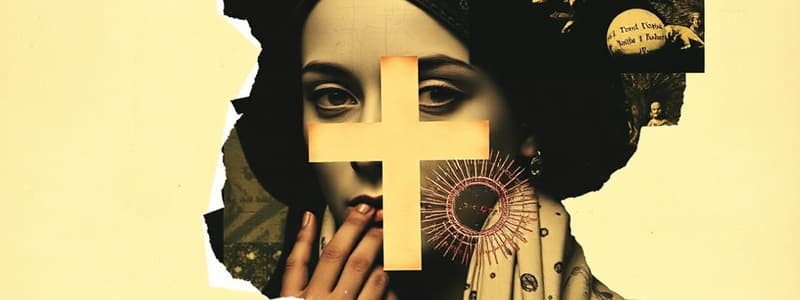Podcast
Questions and Answers
Which of the following best describes the Symbol of Chalcedon's view of Jesus?
Which of the following best describes the Symbol of Chalcedon's view of Jesus?
- Neither fully God nor fully human
- Fully God, but not truly human
- Truly God and truly human (correct)
- Fully human, but not truly God
According to the Symbol of Chalcedon, how many natures does Jesus possess?
According to the Symbol of Chalcedon, how many natures does Jesus possess?
- Three natures
- No nature
- Two natures (correct)
- One nature
The Symbol of Chalcedon affirms that Jesus is how many persons?
The Symbol of Chalcedon affirms that Jesus is how many persons?
- Two persons
- No person
- Three persons
- One person (correct)
What does the term 'traditores' mean?
What does the term 'traditores' mean?
In what year did a major dispute erupt at Carthage regarding traditores?
In what year did a major dispute erupt at Carthage regarding traditores?
Which title for Mary is affirmed by the Symbol of Chalcedon?
Which title for Mary is affirmed by the Symbol of Chalcedon?
What did the Donatists believe about the sacraments performed by traditores?
What did the Donatists believe about the sacraments performed by traditores?
The belief that Christ was one unified person, embodying 2 realities corresponding to his 2 natures was held by which group?
The belief that Christ was one unified person, embodying 2 realities corresponding to his 2 natures was held by which group?
Who were the Donatists named after?
Who were the Donatists named after?
Who suppressed the Donatists through legislation and force?
Who suppressed the Donatists through legislation and force?
What does the Greek term 'Theotokos' refer to?
What does the Greek term 'Theotokos' refer to?
What was a key characteristic of the Alexandrian theological perspective?
What was a key characteristic of the Alexandrian theological perspective?
Which city's theologians saw the term 'Theotokos' as legitimate?
Which city's theologians saw the term 'Theotokos' as legitimate?
Who was Nestorius?
Who was Nestorius?
Which theological school of thought emphasized that the divine Son became truly human, possessing a human mind and soul?
Which theological school of thought emphasized that the divine Son became truly human, possessing a human mind and soul?
What potential issue did critics raise regarding the Antiochian perspective?
What potential issue did critics raise regarding the Antiochian perspective?
What was Nestorius's primary concern regarding calling Mary 'God-Bearer'?
What was Nestorius's primary concern regarding calling Mary 'God-Bearer'?
What was the outcome of the Council of Ephesus regarding Nestorius?
What was the outcome of the Council of Ephesus regarding Nestorius?
Which concept was central to the Alexandrian understanding of Jesus?
Which concept was central to the Alexandrian understanding of Jesus?
The Antioch theologians emphasized what aspect of Jesus?
The Antioch theologians emphasized what aspect of Jesus?
What does the Council of Chalcedon affirm about Jesus?
What does the Council of Chalcedon affirm about Jesus?
According to Chalcedon, how many natures does Jesus possess?
According to Chalcedon, how many natures does Jesus possess?
What title is given to the Virgin Mary in relation to Jesus, according to the content?
What title is given to the Virgin Mary in relation to Jesus, according to the content?
What specific heresy does the belief in two natures of Christ guard against?
What specific heresy does the belief in two natures of Christ guard against?
The Church of the East argued that Christ embodied how many realities corresponding to his natures?
The Church of the East argued that Christ embodied how many realities corresponding to his natures?
What did Miaphysites believe about Christ's nature?
What did Miaphysites believe about Christ's nature?
In what modern-day country was Augustine of Hippo born?
In what modern-day country was Augustine of Hippo born?
When did Augustine convert to Christianity?
When did Augustine convert to Christianity?
What is the name of Augustine's autobiographical work?
What is the name of Augustine's autobiographical work?
What were Christian leaders called who turned over scriptures during Diocletian's persecution?
What were Christian leaders called who turned over scriptures during Diocletian's persecution?
What belief did Eutyches promote?
What belief did Eutyches promote?
What is the term for the belief that Jesus had only one, divine nature?
What is the term for the belief that Jesus had only one, divine nature?
Which council addressed the teachings of Eutyches and the controversy surrounding them?
Which council addressed the teachings of Eutyches and the controversy surrounding them?
What was the main argument presented by Leo I against Eutyches's teachings?
What was the main argument presented by Leo I against Eutyches's teachings?
What was the significance of the Tome of Leo?
What was the significance of the Tome of Leo?
Flashcards
Alexandrian Theology
Alexandrian Theology
Emphasized the unity of Jesus's divinity and humanity, focusing on the divine Son becoming flesh.
Criticism of Alexandria
Criticism of Alexandria
The Alexandrian view risked implying Jesus was only a divine being in a material body, not fully human.
Antiochian Theology
Antiochian Theology
Stressed the distinction between Jesus's divinity and humanity, emphasizing the divine Son became fully human, with a human mind and soul.
Criticism of Antioch
Criticism of Antioch
Signup and view all the flashcards
Immutability
Immutability
Signup and view all the flashcards
Traditores
Traditores
Signup and view all the flashcards
310 AD
310 AD
Signup and view all the flashcards
Donatists
Donatists
Signup and view all the flashcards
Invalid Sacraments
Invalid Sacraments
Signup and view all the flashcards
Donatist Persecution
Donatist Persecution
Signup and view all the flashcards
Symbol of Chalcedon
Symbol of Chalcedon
Signup and view all the flashcards
"Truly God and Truly Human"
"Truly God and Truly Human"
Signup and view all the flashcards
"The Mother of God"
"The Mother of God"
Signup and view all the flashcards
Two Natures, One Person
Two Natures, One Person
Signup and view all the flashcards
Nestorianism
Nestorianism
Signup and view all the flashcards
Theotokos
Theotokos
Signup and view all the flashcards
Nestorius's Concern
Nestorius's Concern
Signup and view all the flashcards
Nestorius
Nestorius
Signup and view all the flashcards
Council of Ephesus
Council of Ephesus
Signup and view all the flashcards
Council of Chalcedon
Council of Chalcedon
Signup and view all the flashcards
Jesus' Dual Nature
Jesus' Dual Nature
Signup and view all the flashcards
Virgin Mary's Title
Virgin Mary's Title
Signup and view all the flashcards
One Person of Christ
One Person of Christ
Signup and view all the flashcards
Christ's Two Natures
Christ's Two Natures
Signup and view all the flashcards
Theotokos Reaffirmation
Theotokos Reaffirmation
Signup and view all the flashcards
Who was Eutyches?
Who was Eutyches?
Signup and view all the flashcards
What is Monophysitism?
What is Monophysitism?
Signup and view all the flashcards
Who was Leo I?
Who was Leo I?
Signup and view all the flashcards
What happened at Chalcedon?
What happened at Chalcedon?
Signup and view all the flashcards
Miaphysites
Miaphysites
Signup and view all the flashcards
Augustine of Hippo
Augustine of Hippo
Signup and view all the flashcards
Donatist Controversy
Donatist Controversy
Signup and view all the flashcards
Diocletian's Persecution
Diocletian's Persecution
Signup and view all the flashcards
Study Notes
Miaphosites
- They argued that Christ had only one nature, both human and divine
- Chalcedonians and Monophysites also held this belief
Augustine of Hippo
- Lived from 354 to 430 CE
- He is probably the most influential post-New Testament Christian thinker
- Augustine was born in modern Algeria
- He grew up experimenting with various religions/philosophies
- He converted to Christianity in 386
- He became a bishop by 395
- He chronicled his spiritual journey in his autobiography, Confessions
Donatist Controversy
- During Diocletian’s persecution, some bishops and priests escaped execution by turning over copies of the Scriptures to be destroyed to authorities, or by halting church services
- These Christian leaders became known as "traditores"
Traditores
- They were "ones who hand things over"
- Name comes from the term tradition or traitor
310
- A major dispute arose in Carthage about whether or not traditores could remain legitimate leaders of the church
Donatists
- They rejected the traditores
- Were named after Donatus, one of their early leaders
- Donatists argued that traditores were not worthy to remain Christian leaders and no longer had any spiritual authority
- They insisted that sacraments performed by traditores (baptisms, ordinations, serving Eucharist) were invalid
- Constantine and the Roman government suppressed the Donatists when they refused to recognize the authority of traditor bishops through legislation and force
- This was the first recorded instance of violent persecution of Christians by other Christians
Alexandria (Alexandrians)
- They stressed the unity of Jesus’s divinity and humanity
- They spoke of the divine Son becoming flesh
- They taught that whatever was true of the divine Son was also true of the man Jesus
- In its cities, the view appeared to leave open the possibility that Jesus was a divine being dwelling in a material body but was not fully human
Antioch (Antiochans)
- Stressed the distinction between Jesus’s divinity and his humanity
- They emphasized that the divine Son became truly human, possessing not only human flesh, but a human mind and soul
- To critics, this view appeared to threaten Christ’s full divinity and immutability (unchanging-ness)
Theotokos
- It's a Greek title for Mary that means "God bearer"
- The title was used during increased devotion to her
- Alexandrians saw this title as legitimate
- Antiochenes argued that was misleading to say Mary "gave birth to God."
Nestorius (Nestorianism)
- Bishop of Constantinople, insisted that calling Mary "God-Bearer" risked confusing the divine and human aspects of Jesus
- Nestorius argued that Jesus consisted of 2 distinct "person" (proposal-one divine and one human) which acted in harmony but were not identical/interchangeable
- Critics argued that this view gave Jesus’s humanity too much independence and threatened to undermine his full divinity
Council of Ephesus
- Controversy over Nestorius’s teachings led to this 3rd Ecumenical council
- Nestorius was condemned as a heretic
- Mary’s status as Theotokos was reaffirmed
Eutyches
- A monk from Constantinople, tried to further protect Jesus's unity by insisting he had a single (divine) nature, not two natures
- Mary's status as Theotokos was reaffirmed
Monophysitism
- The belief that Jesus had a single (divine) nature, not two natures
Leo I
- Bishop of Rome, wrote a lengthy letter ("The Tome") to the Bishop of Constantinople in which he denounced Eutyches’s teachings
- His basic argument echoed Irenaeus
- If Jesus was not fully human, then his actions could not redeem those who are fully human
Council of Chalcedon
- In 451, the 4th Ecumenical Council was held at Chalcedon to address the controversy over Eutyches's teaching
- Leo's "tome" was read to the Council
- Monophysitism was condemned as heretical
Symbol of Chalcedon
- Remains the definitive statement on Jesus's nature for Roman Catholic, Eastern Orthodox, and Protestant Christians
- Jesus = "truly God and truly Human"
- "In all things like unto us w/o sin; begotten before all ages"
- Virgin Mary = "the Mother of God"
- Jesus possesses 2 natures
- Jesus is one person
- Christ is one person with 2 complete, distinct, yet inseparable natures - one divine, one human
Two Natures
- Guards against monophysitism
One Person
- Guards against nestorianism
The Church of the East
- The church argued that while Christ was one unified person, he embodied 2 realities corresponding to his 2 natures
- Chalcedonians and Nestorians held this view
Studying That Suits You
Use AI to generate personalized quizzes and flashcards to suit your learning preferences.
Description
Explore key concepts related to the Symbol of Chalcedon, including its view of Jesus and Mary. Understand the Donatist controversy, their beliefs about sacraments, and their suppression. Also, learn about the 'Theotokos' and Nestorius.




